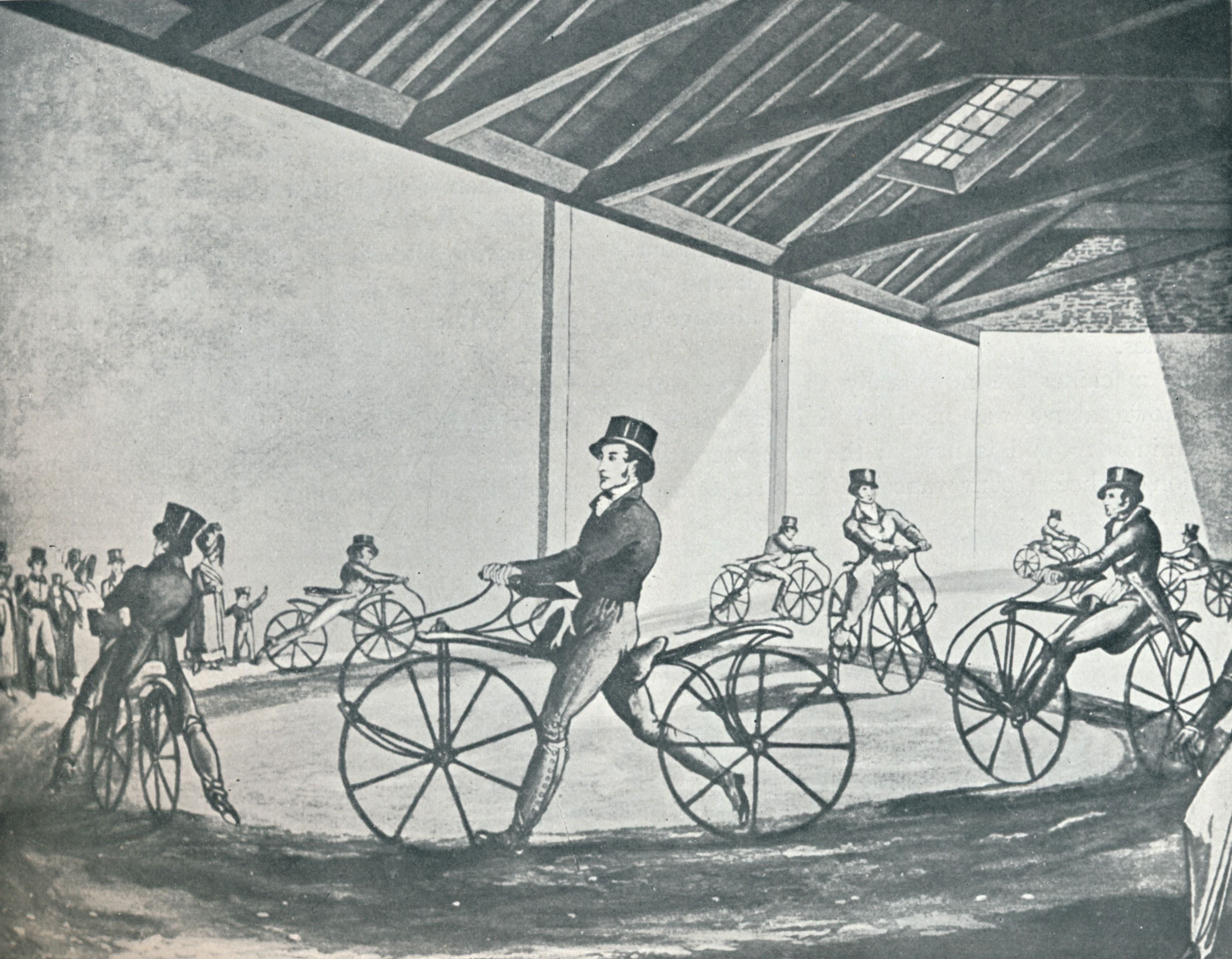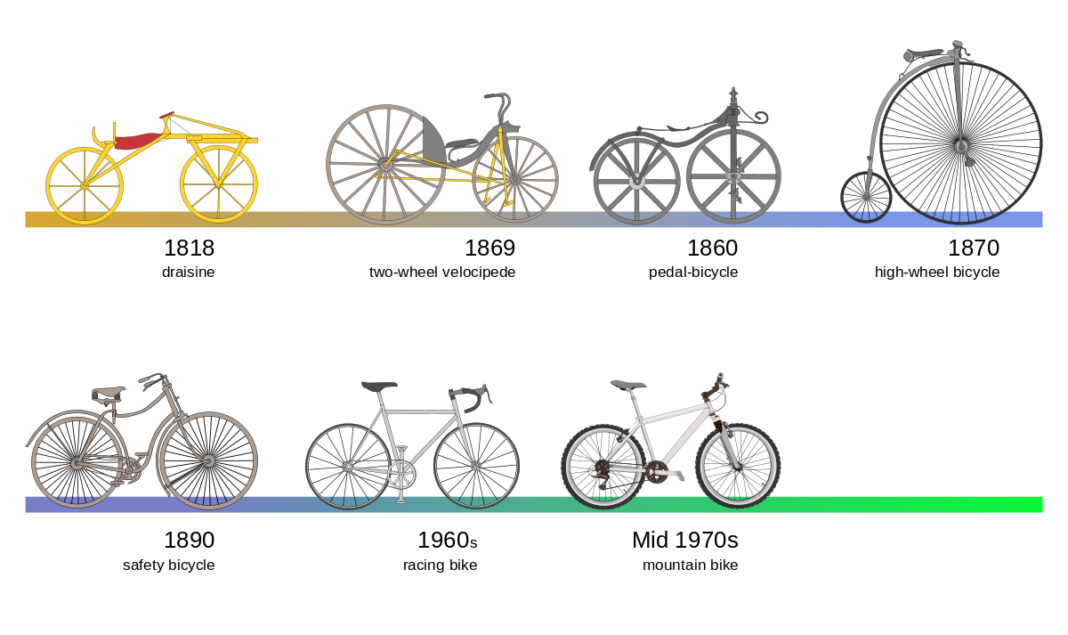The History of First Bicycle, or ‘velocipede’ was invented in the early 1800s and looked very different to the ones we know today. However, you might be surprised to learn how many ‘modern’ bicycles design features aren’t so modern after all. The first ‘bicycle’ was invented in 1817 by German, Baron Karl von Drais…

Who invented the first bicycle?
The first “bicycle” was invented in 1817 by German, Baron Karl von Drais. Technically it was a velocipede (a 2 wheeled human-powered vehicle). It had no pedals, to operate it you had to run. For this reason, it was nicknamed “the hobby horse”. It was constructed almost entirely from wood, with brass bushing and steel-rimmed wheels. As a result, it weighed around 22 kg (48.5 lbs), to put that into context, modern bikes weight about half that.

How did the first bicycles work?
Bicycles nearly looked very different. Before rotating pedals were added, there was the treadle bicycle, invented in 1860. (A treadle is another way of converting a pedal motion into a rotational one. It more closely resembles a cross-trainer.) Fortunately, the crank mechanism proved more popular otherwise bicycle culture might be very different today.

The bicycles, with pedals and cranks, first appeared in France around 1863. These pedals were attached to the front wheel of the bicycle. This design meant that bicycles were difficult to steer
Structure and design
The first bicycles were made from wood, with steel “tires”. The frame shapes were also rather wild and typically curved. Manufacturers moved towards a diamond-shaped body, made from steel tubing as it was much stronger and lighter.

The device earned the name “boneshaker” due to the combination of lack of suspension, steel-rimmed tires, and the poor road surface quality of the time.
The penny-farthing
The penny-farthing was invented as a way of increasing the maximum speed of the bicycle. That is because, in bicycles with front-mounted pedals, the rotational speed is limited to the size of the wheel. However, with a penny-farthing, the maximum speed is still limited by the leg length of the rider.

Penny-farthings were extremely unsafe given their instability and high center of gravity. Riders would frequently die when their legs became trapped in the spokes and they would have to step off their bicycles when traveling downhill, as most brakes were rear-mounted or, in the case of fixed pedals, were operated by simply backpedaling.
Women were also unable to use these bikes, due to the fashions of the time.
The modern bicycle
In the late 1800s, the bicycle, nearly as we know it today, the ‘safety bicycle’, was introduced. The design featured a chain-driven, rear wheel. However, the wheels were often differently sized and the frames were frequently somewhat bizarrely shaped.
Incredibly, they were manufactured using technologies from the sewing industry.

This new design introduced the bicycle to a wider market, including women.
Shortly after this the introduction of pneumatic tires and ball bearing hubs made for a smoother ride.
The upright bicycle became the standard as recumbent bicycles were banned from competitions, due to the increased speed possible with such designs. However, the International Human Powered Vehicle Association seek to promote ‘banned class” bicycles.
Brakes
The first breaks were spoon brakes. They even feature on Karl Drais’s original hobby horse design. They were operated by a cord or lever and pressed down onto the rear wheel.
The front brake was introduced in 1873 by John Kean. It made the penny-farthing slightly safer.

Caliper brakes were patented in 1887 by Browett and Harrison. It worked much as modern brakes do today.
The duck brake was designed in 1897, it prevented wear on the new, modern rubber tires and worked much like the spoon brake.
Rod-actuated brakes or “rod brakes” were fitted to bikes right into the late 1900s. The design featured a stirrup which holds brake shoes and pulls the brake up into the interior of the wheel rim. The braking power was lower than most modern bikes.
Disk brakes, or “U brakes” were developed in the 1890s, however, it wasn’t until 1962 that these were added to two-wheeled vehicles, in the Lambretta TV175 Series 3 Scooter. Disc brakes for bicycles weren’t popularized until the 1990s.
Hydraulic disc brakes were developed in 1994 by USA Sachs (SRAM) – the PowerDisc.
Gears
Patents for epicyclic hubs date back to the mid-1880s. Before epicyclic gears were used in bicycle hubs, they were used on tricycles and quadricycles. Although tricycles and quadricycles were popular, no one made the connection between these and the humble hobby horse for quite some time!
Until the 1930s cyclists were unable to use gearing in competition bicycles. They were allowed only a 2-speed bicycle. To change gear the cyclist had to remove the wheel and flip it!
Recently a “1% friction” gear system has been invented. It has no drive train and no chain! This converts 8 points of sliding friction into 2 points of rotating friction.
Modern trends
If you think that folding bikes and electric bikes are a modern invention, you’d be wrong.

The first folding bike was created in 1878, England by Grout. It was a penny-farthing! Although some people do not consider this to be a ‘true’ example of a folding bike, many other versions exist well before the 1900s.
The first battery-powered bicycle or ‘e-bike’ was patented in 1895, US by Ogden Bolton Jr.
The cycling fad and fade
The bicycle was nearly a blink in the history books. Cycling began as a fashionable sport available only to rich, young, and fit men. By the 1870s, almost everywhere but the UK, cycling fell out of fashion. Thankfully, by the mid-1870s, the popularity of the penny-farthing found its way back to France and by the late 1870s the Americans had got in on the act too, importing the penny farthing and later manufacturing it themselves. By 1891 as much as ten percent of all advertising in U.S. periodicals was by bicycle makers.

The Tour de France and other cycling competitions fueled the popularity for cycling in Europe during the early 1900s. Whereas, in America, the motorcar gained popularity and bicycles were considered a “children’s toy”. They returned to fashion in the 1980s when the fitness craze hit.









